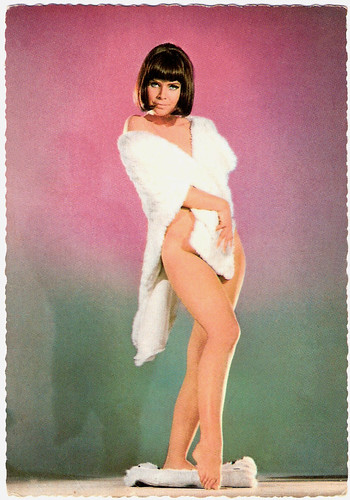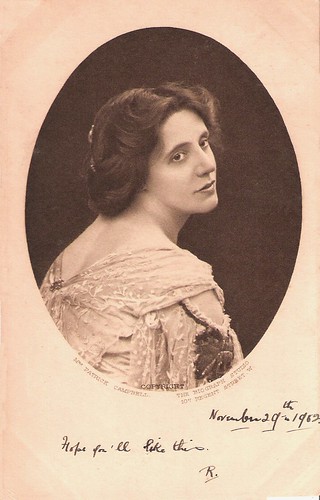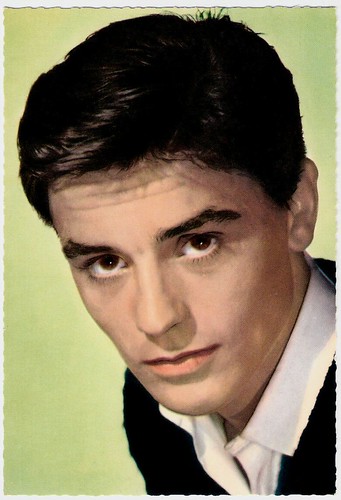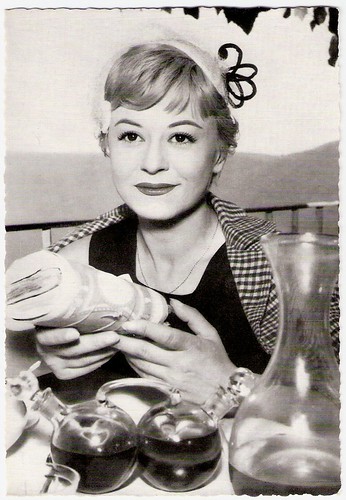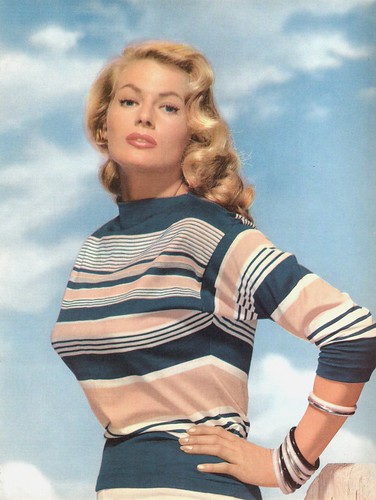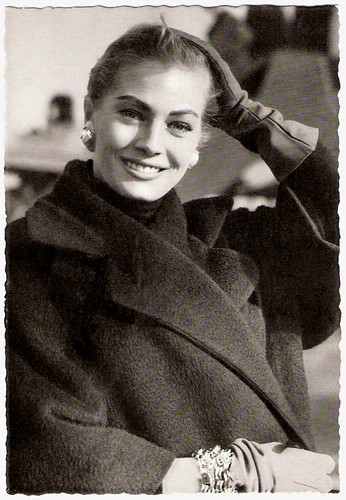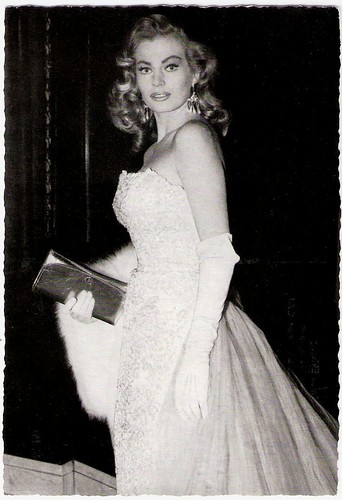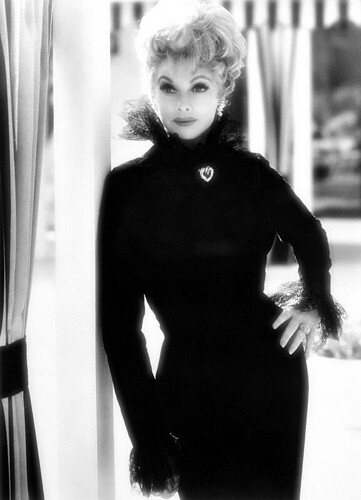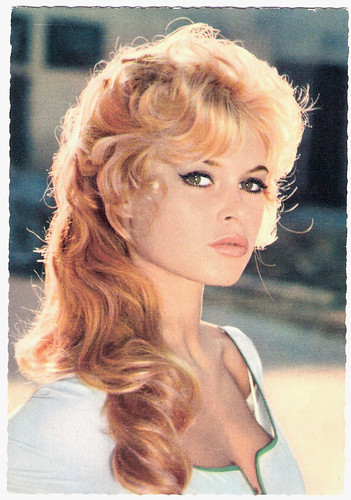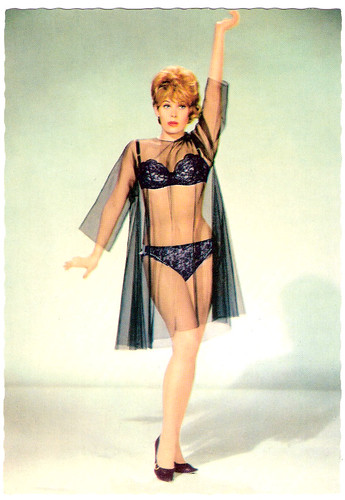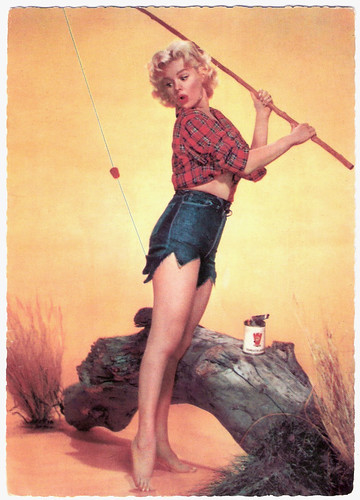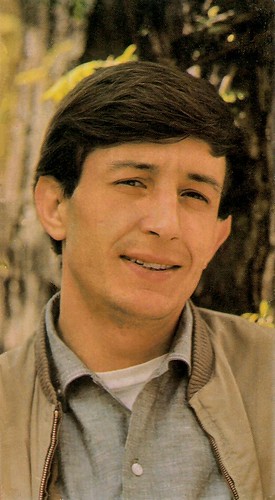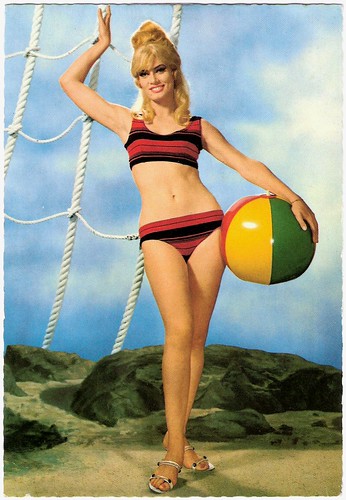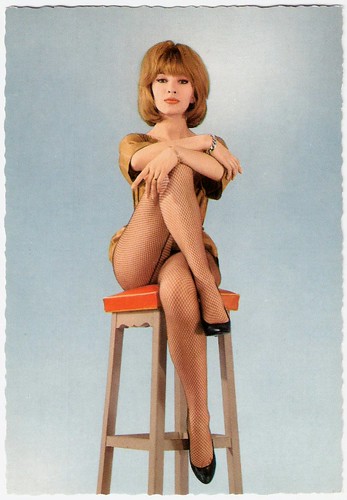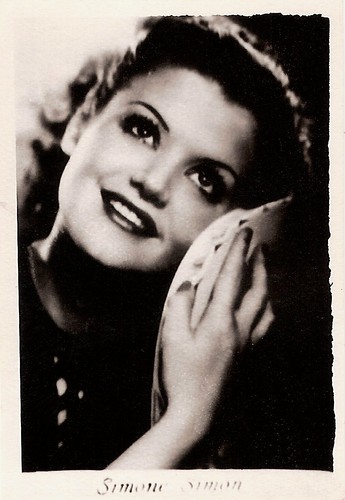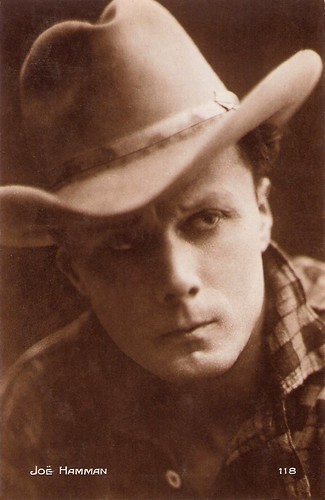German postcard by Krüger, nr. 900/271.
Mrs. Patrick Campbell
Mrs Patrick CampbellBritish postcard by The Biograph Studio, London. Sent by mail in 1902.
British actress Mrs Patrick Campbell (1865-1940) was by far the biggest name on the London stage of the belle époque, famous for her wit, temperament and beauty. She was the original Eliza Dolittle in Pygmalion (1914) a part written especially for her by her lifelong friend George Bernard Shaw. In her later years, ‘Mrs. Pat’ made notable film appearances as a dowager in One More River (1934) and in Crime and Punishment (1935).
Mrs. Patrick Campbell was born Beatrice Stella Tanner in Kensington, London, in 1865. Her parents were John Tanner and Maria Luigia Giovanna, daughter of Count Angelo Romanini. She studied for a short time at the Guildhall School of Music. She was well-known as an amateur before she made her stage debut in 1888 at the Alexandra Theatre, Liverpool, four years after her marriage to Patrick Campbell. In March, 1890, she appeared in London at the Adelphi, where she afterward played again in 1891–93. She became successful as a result of starring in Sir Arthur Wing Pinero's play, The Second Mrs Tanqueray, in 1893, at St. James's Theatre where she also appeared in 1894 in The Masqueraders. As Kate Cloud in John-a-Dreams, produced by Beerbohm Tree at the Haymarket in 1894, she made another success, and again as Agnes in The Notorious Mrs. Ebbsmith at the Garrick (1895). Among her other performances were those in Fédora (1895), Little Eyolf (1896), and her notable performances with Forbes-Robertson at the Lyceum in the roles of Juliet in Romeo and Juliet, Ophelia in Hamlet, and Lady Macbeth (1895–1898) in Macbeth. Her first marriage to Patrick Campbell in 1884, from which she took the name by which she is generally known, produced two children, Alan Urquhart ('Beo'), who was killed in WWI, and Stella, who married an American and moved to Chicago. Campbell’s own marriage ended with the death of her husband in the Boer War in 1900. Fourteen years later, she became the second wife of Major George Frederick Myddleton Cornwallis-West, a dashing writer and soldier previously married to Jennie Jerome, the mother of Sir Winston Churchill.
In 1902, Mrs. Patrick Campbell made her debut performance on Broadway in New York City in Hermann Sudermann’s Magda, a marked success. Subsequent Broadway roles included The Joy of Living (1902), as Melisande to the Pelleas of Sarah Bernhardt in Maurice Maeterlinck’s Pelléas et Mélisande (1904), as Hedda Gabler in Henrik Ibsen’s play of the same name (1907), The Thunderbolt (1908), Lady Patricia (1911), and Bella Donna (1911). She would return to perform there on a number of occasions until 1930. She was described by one American producer as a temperamental actress whose "grand sense of humor and outstanding charm made you laugh instead of strangle her". One of her most famous quotes was " It doesn't matter what you do in the bedroom as long as you don't do it in the streets and frighten the horses." In 1914, she played Eliza Doolittle in the original production of George Bernard Shaw's Pygmalion; though much too old for the part at 49, she was the obvious choice, being by far the biggest name on the London stage, and Shaw would have seen it no other way since he wrote the play for her in particular. She and Shaw conducted a famous correspondence for many years. Despite her second marriage, to George Cornwallis-West, she continued to use the stage name Mrs Patrick Campbell. Her last stage appearance came in 1933.
Mrs. Patrick Campbell had made her film début in the silent film The Money Moon (1920, Fred Paul). When the sound film came along, she went to Hollywood and appeared in The Dancers (1930, Chandler Sprague) with Lois Moran and Mae Clarke. She also became a speech teacher and dialogue coach and made instructional films for aspiring actors who wanted to break into the sound film. Campbell herself made some notable film appearances, including Riptide (1934, Edmund Goulding) starring Norma Shearer, One More River (1934, James Whale) with Diana Wynyard, and as the villainous pawnbroker in Crime and Punishment (1935, Josef von Sternberg) featuring Peter Lorre. She was legendary for making astonishingly inappropriate remarks. She undoubtedly lost her chance for a career in Hollywood when, at a party, she approached MGM executive Irving Thalberg, married to Norma Shearer, and said: "Dear Mr. Thalberg, how is your lovely, lovely wife with the tiny, tiny eyes?". Mrs. Patrick Campbell died in 1940 in Pau, France, at age 75. The onset of WWII had caught her in the French Pyrenees, ill and destitute. She could not return to England because quarantine laws would have imprisoned her Pekinese, Moonbeam. Her nurse cabled Sara and Gerald Murphy for funds, which were sent but arrived too late and were used to bury the former diva in the Cimetiere Urbain at Pau.
Sources: Hans J. Wollstein (All Movie Guide), Harry Rusche (Shakespeare’s World), Encyclopaedia Britannica, Wikipedia, and IMDb.
Jacques Sernas
Jacques SernasLithuanian-born French actor Jacques (sometimes: Jack) Sernas (1925) had an international film career of more than sixty years. First the handsome blonde appeared as the hero of peplum spectacles and adventure films and later he worked as a character actor. Sernas is perhaps best-known as Paris in the Hollywood epic Helen of Troy (1956)
Elissa Landi
Elissa LandiItalian born actress and writer Elissa Landi (1904–1948) was rumoured to be a descendant of Emperor Franz Joseph of Austria. During the 1920’s she appeared in British, French, and German films before travelling to the United States. In Hollywood she became a popular star of the 1930’s.
Elvire Popesco
Elvire PopescoElvire Popesco (1894-1993) was a French actress of Romanian origin. In the twenties she went to Paris, where she conquered the stages with her comic talent and heavy accent. In the thirties she became a popular film star, who worked with such great directors as Julien Duvivier, Abel Gance, Sacha Guitry, and Marc Allégret.
Alain Delon
Alain DelonIn the late 1950’s and early 1960’s Alain Delon (1935) was the breathtakingly good-looking James Dean of the French cinema. The “male Brigitte Bardot” soon proved to be a magnificent actor in masterpieces by Luchino Visconti and Michelangelo Antonioni. In the late sixties Delon came to epitomise the calm, psychopathic hoodlum in the 'policiers' of Jean-Pierre Melville, staring into the camera like a cat assessing a mouse
Lana Turner was an American film and television actress
Lana TurnerJulia Jean "Lana" Turner was an American film and television actress. Discovered and signed to a film contract by Metro-Goldwyn-Mayer at the age of sixteen, Turner first attracted attention in They Won't Forget. She played featured roles, often as the ingenue, in such films as Love Finds Andy Hardy. During the early 1940s she established herself as a leading actress in such films as Johnny Eager, Honky Tonk, Ziegfeld Girl and Somewhere I'll Find You. She is known as one of the first Hollywood scream queens thanks to her role in the 1941 horror film Dr. Jekyll and Mr. Hyde, and her reputation as a glamorous femme fatale was enhanced by her performance in the film noir The Postman Always Rings Twice. Her popularity continued through the 1950s, in such films as The Bad and the Beautiful and Peyton Place, for which she was nominated for an Academy Award for Best Actress. In 1958, her daughter, Cheryl Crane, stabbed Turner's lover Johnny Stompanato to death. A coroner's inquest brought considerable media attention to Turner and concluded that Crane had acted in self-defense
Gallery for vintage actress Lana Turner
Giulietta Masina
Giulietta MasinaItalian film and stage actress Giulietta Masina (1921-1994) starred in the classics La strada (1954) and Notti di Cabiria (1957), both directed by her husband Federico Fellini and both winners of the Oscar for Best Foreign Language Film. The only 1,57 m long Masina was often called the ‘female Chaplin’. The skilled, button-eyed comedienne could deliver intense dramatic performances of naive characters dealing with cruel circumstances.
Anita Ekberg
Anita EkbergSwedish film actress, party-girl and sex symbol Anita Ekberg (1931) was nicknamed The Iceberg. Miss Sweden 1950 was contracted by Howard Hughes, had a Hollywood career in the 1950’s, but got her real breakthrough in Italy. She made film history as the sensual, curvaceous film goddess who dances in the Trevi Fountain in Fellini’s La Dolce Vita (1960).
Anita Ekberg
Anita EkbergSwedish film actress, party-girl and sex symbol Anita Ekberg (1931) was nicknamed The Iceberg. Miss Sweden 1950 was contracted by Howard Hughes, had a Hollywood career in the 1950’s, but got her real breakthrough in Italy. She made film history as the sensual, curvaceous film goddess who dances in the Trevi Fountain in Fellini’s La Dolce Vita (1960).
Grace Kelly Dial M for Murder 1954
Grace KellyDial M for Murder is a 1954 American thriller film adapted from a successful stage play and directed by Alfred Hitchcock and released by Warner Bros. It stars Ray Milland as a retired tennis pro who wishes to have his wife killed, Grace Kelly as the wife, and Robert Cummings as her paramour. The supporting cast includes John Williams as the police detective who investigates the matter and Anthony Dawson as the man hired to do the killing.
The screenplay and the stage play on which it was based were both written by English playwright Frederick Knott (1916–2002), whose work tends to focus on women who innocently become the potential victims of sinister plots. The original play premiered in 1952 on BBC television, before being performed on the stage in the same year (West End in June, and then Broadway in October).
There is just one setting in the stage play: the living-room of the Wendices' flat in London (61A Charrington Gardens, Maida Vale). Hitchcock's film adds a second setting in a gentleman's club, a few views of the street outside and a stylized courtroom montage. Having seen the play on Broadway, Cary Grant was keen to play the role of Tony Wendice, but studio chiefs did not feel the public would accept him as a man who arranges to have his wife murdered.
In June 2008, the American Film Institute revealed its "Ten Top Ten"—the best ten films in ten "classic" American film genres—after polling over 1,500 people from the creative community. Dial M for Murder was ranked the ninth best film in the mystery genre in the list
plot
Tony Wendice (Milland) is an ex-professional tennis player who lives in a London flat with his wealthy wife, Margot (Kelly). Tony retired after Margot complained about his busy schedule, and she began an affair, which he secretly discovered, with American crime-fiction writer Mark Halliday (Cummings). Motivated by resentment, jealousy, and greed, Tony has devised a plan to have Margot murdered.
When Mark visits England, Margot introduces him to Tony as a casual acquaintance. After sending the two lovers out for the evening, Tony makes an excuse to meet at the flat with petty criminal C.A. Swann (Dawson), an old acquaintance from Cambridge. Tony has been following Swann in order to blackmail him into committing the murder. Tony tells Swann of Margot's affair, including a love letter from Mark which she once kept in her handbag. Six months ago, Tony stole the handbag and anonymously blackmailed her. After tricking Swann into leaving his fingerprints on the letter, Tony offers to pay him £1,000 to kill Margot. If he refuses, Tony will turn him in to the police as the blackmailer.
Cummings, Kelly, and Milland
When Swann agrees, Tony explains his plan: He will take Mark to a party, leaving Margot at home and hiding her latchkey under the carpet on the staircase outside the front door of the flat. Swann is to sneak into the flat after Margot goes to bed and hide behind the curtains in front of the French doors leading to the garden. When Tony telephones from the party, Margot will go to the phone. Swann is to kill her from behind, open the French doors, and leave signs suggesting a burglary gone wrong, then exit through the front door, again hiding the key under the staircase carpet.
The plan works until Tony phones the flat. Swann tries to strangle Margot with a scarf, but she stabs and kills him with a pair of scissors, then picks up the telephone receiver and pleads for help. Realizing the plan has gone wrong, Tony tells her not to do anything. At home, he finds what he assumes is Margot's latchkey in Swann's pocket and puts it in her handbag, then calls the police, sends Margot to bed, plants Mark's letter on Swann, and replaces Swann's scarf with one of Margot's stockings. He also persuades Margot to hide the fact that he told her not to call the police. The next day, Chief Inspector Hubbard (Williams) questions the Wendices and Margot makes several conflicting statements. When Hubbard explains that Swann must have entered through the front door, Tony falsely claims to have seen Swann after Margot's handbag was stolen and suggests that Swann made a copy of her key. Hubbard arrests Margot after concluding that she killed Swann for blackmailing her with Mark's letter when he came to collect.
Margot is sentenced to death for murder. On the day before her scheduled execution, Mark tries to persuade Tony to save her by telling the police that he hired Swann to kill her, not realizing that this is what actually happened. Tony refuses, insisting the story is too unrealistic, just before Hubbard arrives. With Mark hiding in the bedroom, Hubbard asks Tony about money he has been spending lately, tricks him into revealing that his latchkey is in his raincoat, and asks him about an attaché case. Tony claims to have lost the case, but Mark notices it on the bed, full of cash. Realizing his story is true, Mark stops Hubbard from leaving and explains his theory. Hubbard claims to prefer Tony's story that Margot gathered the money to pay Swann before deciding to kill him, but after Mark leaves, Hubbard discreetly swaps his own raincoat with Tony's, and as soon as Tony has left, he uses Tony's key to re-enter the flat. He really does suspect Tony, having discovered that the key in Margot's handbag was Swann's.
Mark returns after seeing Tony leave. Meanwhile, on Hubbard's orders, police officers release Margot outside. She tries to unlock the door with the key in her purse, then enters through the garden, proving she is unaware of the hidden key. Hubbard has the handbag returned to the police station, where Tony retrieves it after discovering that he has no key. When he is unable to unlock the front door with the key from the bag, he finds Margot's key on the staircase and opens the door, proving his guilt. With his escape routes blocked by Hubbard and another policeman, Tony surrenders. Source
Judy Canova arcade postcard - 1940s
Judy Canova
A true country singer, stgarted in radio in the 30s, singing on a program with some family members. In the 40s she became a popular star of movie (B comedies and musicals). In the mid 50s the interest in her much dated music and humor had died off and she retired
John Boles 1930, movies leading man
John BolesJohn Love Boles (October 28, 1895 – February 27, 1969) was an American actor. Boles was born in Greenville, Texas, into a middle-class family. He graduated with honors from the University of Texas in 1917 and married Marielite Dobbs in that same year. His parents wanted him to be a doctor and Boles studied and finally got his B.A. degree, but the stage called. John Boles preferred acting and singing, and he demonstrated talents for them from an early age and this won him a place alongside Gloria Swanson when she chose him to play in film with her. During World War I, he was a US spy in Germany, Bulgaria, and Turkey. He started out in Hollywood in the silent movie era, but became a huge star with the advent of talkies. After the war, Boles moved to New York to study music. He quickly became well-known for his talents and was selected to play the leading man in the 1923 Broadway musical Little Jesse James. He became an established star on Broadway source
Gallery for vintage actor John Boles
Richard Burton Hollywood actor born in Wales
Richard BurtonRichard Burton, CBE (10 November 1925 – 5 August 1984) was a Welsh actor. He was nominated seven times for an Academy Award, six of which were for Best Actor in a Leading Role (without ever winning), and was a recipient of BAFTA, Golden Globe and Tony Awards for Best Actor. Burton was at one time the highest-paid actor in Hollywood. He remains closely associated in the public consciousness with his second wife, actress Elizabeth Taylor; the couple's turbulent relationship was rarely out of the news. Richard Burton was born Richard Walter Jenkins in the village of Pontrhydyfen, Neath Port Talbot, Wales. He grew up in a working class, Welsh-speaking household, the twelfth of thirteen children. His father, Richard Walter Jenkins, was a short, robust coal miner, a "twelve-pints a-day man" who sometimes went off on drinking and gambling sprees for weeks source
Brigitte Bardot
Brigitte BardotBrigitte Bardot (1934) was the sex kitten of the European cinema. She was every man's idea of the girl he'd like to meet in Paris.
For more postcards, a bio and clips check out our blog European Film Star Postcards.
We continue our series of postcards of 'la belle BB'. ISV also produced this card with a photograph that must be taken at the same session, or is it even the same photo, mirrored and colored?
Brigitte Bardot
Brigitte BardotGerman postcard by ISV, nr. H 87.
Brigitte Bardot (1934) was the sex kitten of the European cinema. She was every man's idea of the girl he'd like to meet in Paris.
For more postcards, a bio and clips check out our blog European Film Star Postcards.
Sybille Schmitz started her career in the era of the silent cinema
Sybille SchmitzBeautiful German actress Sybille Schmitz (1909-1955) started her career in the era of the silent cinema. With her typical face and her relaxed, slightly mysterious way of playing, she became a prominent Ufa star during the Third Reich. After the war she was beset by drug abuse and depression and at 45, she committed suicide.
Gallery for vintage actress Sybille Schmitz
John Martin Harvey in roll
John Martin HarveyBritish Rotophot postcard by J. Beagles & Co, London, nr. 9185. Photo: Stereoscopic Co., Berlin.
British Actor-manager Sir John Martin Harvey (1863-1944) was one of the last great romantic actors of the English theatre. His most famous play was The Only Way (1899), an adaptation of Charles Dickens' A Tale of Two Cities. 25 years later, he also featured in the film version, as well as in a few other silent and sound films.
John Martin Harvey
John Martin HarveyBritish postcard by Rotary, nr. 115 N. Photo: London Stereoscopic Co. Still for Rouge de l'isle.
British Actor-manager Sir John Martin Harvey (1863-1944) was one of the last great romantic actors of the English theatre. His most famous play was The Only Way (1899), an adaptation of Charles Dickens' A Tale of Two Cities. 25 years later, he also featured in the film version, as well as in a few other silent and sound films.
Barbara Lang
Barbara LangGerman postcard by ISV, B 11. Photo: MGM. Still for House of Numbers (1957, Russell Rouse).
Leny Escudero
Leny EscuderoBelgian postcard by S. Best, Anvers (Antwerp), nr. 25. Gift card for Victoria chocolates.
Popular French singer Leny Escudéro (1932) did not want to be a star, but performed his songs to help others. He also appeared in committed roles in films and on tv.
Gianni Morandi
Gianni MorandiSpanish postcard by Postal Oscar Color S.A., Hospitalet (Barcelona), nr. 302. Photo: RCA Victor.
Italian pop singer and entertainer Gianni Morandi (1944) reportedly sold more than 30 million recordings and appeared in 18 films. In 1970, he represented Italy at the Eurovision Song Contest with Occhi di ragazza. His career went into a decline in the late 1970’s but underwent a revival in the 1980’s. He won the San Remo Festival in 1987, placed second in 1995 and third in 2000. Having enjoyed four decades of unmatched success, Gianni Morandi is among Italy's greatest performers of all time.
Gian Luigi Morandi was born in the village of Monghidoro on the Tuscan-Emilian Apennines in 1944. His father Renato was active within the Italian Communist Party and Gianni used to help him sell the party newspapers. To make ends meet Morandi worked at an early age as a shoe-shiner, cobbler and as a soda and candy vendor in the village's only cinema. He made his performance debut at age 12, singing in the public square on New Year's Day, 1956. His vocal abilities led him to a number of small gigs, some of which were during the Communist Party’s activities. His parents moved him from traditional schooling to a school in Bologna, where he studied song and performance with master vocalist Alda Scaglioni. He made his official debut in 1958 in Alfonsine, Ravenna; and he made his film debut in the comedy Totò ciak/Totò Clapper Loader (1960, Daniele D'Anza) starring the popular comedian Totò. Morandi formed a band, and was soon referred to as the Italian Paul Anka. In 1962, Morandi won a small talent competition where he met and impressed boxing and entertainment promoter Paul Lionetti, who arranged an audience with executives of RCA Victor. He was signed by RCA Italia and his premier 45 was Andavo a Cento All'ora (I Went to 100 per Hour).
Gianni Morandi achieved national stardom with his third 45, Fatti mandare dalla mamma (Let Your Mother Send You). Some of his songs took momentum through soundtracks of such films as I maniaci/The Maniacs (1964, Lucio Fulci) starring Walter Chiari, and 008: Operation pace/008: Operation Peace (1965, Tullio Piacentini). Morandi also starred in several musicarelli, typical Italian musicals with a flimsy plot, shot and edited in no time after a song had become a hit. During the production of the first of these films, In ginocchio da te/On My Knees For You (1964, Ettore Maria Fizzarotti), Morandi met Laura Efrikian. She was the daughter of a famous conductor of Armenian origin and she was already an established actress. They married secretly in 1966 and when Laura was pregnant Morandi’s military service was temporarily postponed. Later, on leave from military service, Gianni worked on the film Per amore… per magia/For Love…For Magic (1966, Ducio Tessari), an ambitious cross between a musical and the story of Aladdin. The film was a flop at the box office. Throughout the 1960’s he remained Italy’s darling. His songs Non son degno di te (I Am Not Worthy of You) and Scende la pioggia (The Rain Comes Down) were certified as having each sold over one million copies, and were awarded gold discs. He won a number of Italian popular song festivals, including the Canzonissima festival in 1965 with Non son degno di te, in 1968 with Scende la pioggia and in 1969 with Ma chi se ne importa (But Who Cares?).
In 1970 Gianni Morandi represented Italy in Amsterdam at the Eurovision Song Contest with Occhi di Ragazza (Eyes of a Girl). He finished eighth out of eleven. During the late 1970’s he experienced a period of slight decline, but he regained popularity during the 1980s. He won the San Remo Festival in 1987 with Si può dare di più (One Can Give More) together with Enrico Ruggeri and Umberto Tozzi. With Barbara Cola he became 2nd in 1995 with In amore (In Love) and he became 3rd in 2000 with Innamorato (Being In Love), written by Eros Ramazotti. At a performance for War Child in 1999 he sang Maria, Marí together with Luciano Pavarotti. It is estimated that Morandi has sold 30 million recordings. He has written a number of autobiographical books and appeared in 18 films. Morandi also was the host in popular Italian television shows and played as an actor in several TV series, a.o. as Claude Jade's husband Davide in Voglia di volare/Wanting to Fly (1984, Pier Giuseppe Murgia). His later feature films included Il provincial/The Provincial (1971, Luciano Salce), La cosa buffa/The Funny Thing (1972, Aldo Lado), the comedy F.F.S.S. cioè che mi hai portato a fare sopra a Posillipo se non mi vuoi più bene?/The National railways, Or Why Did You Bring Me All the Way to Posillipo if You Don’t Love Me Anymore? (1983, Renzo Arbore) and Panni sporchi/Dirty Linen (1999, Mario Monicelli) with Mariangela Melato and Ornella Muti. Gianni Morandi has 3 children: Marco Morandi and Marianna Morandi from his first wife, Laura Efrikian (they divorced in 1979), and Pietro from his second wife, Anna Dan, whom he married in 2005.
Sources: Evan C. Gutierrez (All Music Guide), Wikipedia and IMDb.
Marisa Mell
Marisa Mell
Curvaceous Austrian actress Marisa Mell (1939-1992) became a cult figure of 1960’s Italian B-films. Her most famous role is criminal mastermind Eva Kant in Mario Bava’s Diabolik (1968).
Brigitte Helm
Brigitte HelmGerman actress, best remembered as the star of Fritz Lang's "Metropolis" (1927).
Margot Hielscher appeared in 60 films and 200 TV productions
Margot HielscherGerman singer, film actress and costume designer Margot Hielscher (1919) appeared in 60 films and 200 TV productions. She represented Germany twice at the Eurovision Song Contest, in 1957 and 1958. With 90 years she is now the oldest living person who ever participated in the Eurovision Song Contest.
Margot Hielscher was born in Berlin in 1919. Her father owned a travel agency. From 1935 till 1939 she trained as a costume and fashion designer. Thus she met in Berlin the contemporary stars of the cinema and the music world. This stimulated her to study singing and acting, and she took classes with Albert Florath and Mary Koppenhöfer. Since 1939, she worked as a costume designer for the Ufa. One of the first films on which she worked was the comedy Hurra, ich bin Papa!/Hurrah! I'm a Papa (1939, Kurt Hoffmann) starring Heinz Rühmann. Rühmann later asked her to marry him, which she refused. Soon she also was discovered as an actress. In 1940 she made her first film appearance in Das Herz der Königin/The Heart of the Queen (1940, Carl Froelich) alongside the famous Zarah Leander. For the Terra studio she appeared in the romance Auf Wiedersehn, Franziska!/Goodbye, Franziska! (1941, Helmut Käutner) starring Marianne Hoppe. From 1942 on she worked for the Bavaria Studio in Munich. She played roles in several romantic comedies in which she also performed as a singer and she soon became one of the most popular actresses of the German cinema during the Second World War. In 1943 she sang the song Frauen sind keine Engel (Women are No Angels) in the film with the same title by Willy Forst. It would become her best known song. During the war, Hielscher undertook several tours for the troops as a singer with the Big Band of Gene Hammers. According to IMDb, Josef Goebbels thought her singing was too ‘American’. He insisted that she shouldn't play opposite Ferdinand Marian in the film Dreimal Komödie/3 x Comedy (1944-1949, Victor Tourjansky) because she wasn't ‘German’ enough. At that time, all the film castings had to be agreed on by Goebbels. However, after another screen-test with some more ‘German’ make-up, Goebbels finally agreed on her casting.
After the war, Margot Hielscher had her career high, when she appeared in front of enthusiastic GI’s with her show Margot´s Revue. She contributed as a co-screenwriter to the film Hallo Fräulein/Hello Fraulein (1949, Rudolf Jugert), which was partially based on her experiences of the immediate post-war period. While shooting this film, she also met her future husband, film composer Friedrich Meyer. 10 years later followed their wedding. IMDb writes that she decided to obtain a pilot's licence in Switzerland in 1952 because her friend Herbert von Karajan cynically told her that it was a good thing that there still were certain things that were only for men. Hielscher proved him wrong and passed her test with one less lesson. In the 1950’s she focussed on her singing career and many of her film appearances were only vocal numbers, such as in the noir Nachts auf den Straßen/Detour (1952) starring Hans Albers and Hildegard Kneff . She incidentally appeared in international films such as The Devil Makes Three (1952, Andrew Marton) starring Gene Kelly, and Nel gorgo del peccato (1954, Vittorio Cottafavi) with Franco Fabrizi. Her voice was a mix of jazz vocals and operetta soprano. In 1957, Hielscher was chosen to represent Germany at the Eurovision Song Contest with the song Telefon, Telefon (Telephone, Telephone). The song finished 4th out of 10 songs, and gained a total of 8 points. Hielscher was chosen again to represent Germany at the Eurovision Song Contest 1958 with the song Für Zwei Groschen Musik (Music For Two Pennies). The song finished 7th out of 10 songs, and gained a total of 5 points.
Margot Hielscher went on to appear in countless TV shows and series till the late 1980’s. Among her series were Salto mortale (1969) with Gustav Knuth, and the comedy series Suchen Sie Dr. Suk! (1972) with Ferdy Maine. For the Bayerischen Fernsehen (Bavaria TV), she was the host of the 1960’s TV show Zu Gast bei Margot Hielscher (Hosted by Margot Hielscher), in which she received some 700 guests including Maurice Chevalier and Romy Schneider. She incidentally played in films, including the period sex comedy Frau Wirtins tolle Töchterlein/The Countess Died of Laughter (1973, Franz Antel) and the Thomas Mann adaptation Der Zauberberg/The Magic Mountain (1982, Hans W. Geissendörfer) with Rod Steiger. In 1991 and 1992 she performed in the Stephen Sondheim musical Follies alongside Eartha Kitt in the Theater des Westens (Theater of the West) in Berlin. After final roles in the TV series Rivalen der Rennbahn/Rivals at the Race Track (1989) and Der Nelkenkönig/The Carnation King (1994, Franz Josef Gottlieb) she finally pulled back from the film business, but kept appearing regularly in the theater. Recently she performed in the Philharmonie München (Munich Philharmonic) in 2006, in the Philharmonie Berlin (Berlin Philharmonic) in 2007 and in the Komödie im Bayerischen Hof München (Comedy in the Bayerischer Hof Munich) in 2008, with Christian Ude . In 1978 she received the Bundesverdienstkreuz (Germany’s Order of Merit) and in 1985 she was awarded with the Filmband in Gold for long and outstanding achievements in German film. Since 1942 Margot Hielscher lives in the Munich district of Bogenhausen (Duke Park).
Sources: Alexander Darda (Margot-Hielscher.de), Thomas Staedeli (Cyranos), StepahnieD’heil (Steffi-Line), Wikipedia and IMDb.
Hedy Lamarr the most beautiful woman in films
Hedy LamarrGlamorous and seductive film star Hedy Lamarr (1913–2000) was born in Austria. The notorious Czechoslovak film Ecstasy made her an international sensation, and Louis Mayer invited her to Hollywood where she became ‘the most beautiful woman in films’.
Gallery for vintage actress Hedy Lamarr
Gracie Fields
Gracie FieldsGracie Fields (1898-1979), born Grace Stansfield, was a British singer, comedienne and stage and film actress. In the 1930s she was a top box office draw and the best paid actress in Britain.
Born over a chip shop in Rochdale, Lancashire, Gracie Fields started as child actor in 1905. Her two sisters and brother went to stage too, but Gracie proved to be more successful. In 1910 she had her professional debut in variety in Rochdale. Fields met comedian Archie Pitt and joined forces. Pitt became her manager, and the two married in 1923. Between 1915 and 1924 they toured the UK with their revues; with the last revue Mr Tower of London Fields reached West End, started a dramatic career and the recording of her songs too. Fields became a wildly popular music-hall singer with her particular style of “a mixture of self-deprecating jokes, comic songs and monologues, as well as cheerful "depression-era" songs all presented in a "no-airs-and-graces" Northern, working class style”, as Wikipedia writes. Because of her strong interaction with her audiences, Fields caused sold out theatres all over Britain and became one of the highest paid performers.
In the 1930s Fields reached the peak of her career and was awarded various honours. After her marriage with Pitt fell down, she donated her London house to a maternal hospital. When she fell ill with cancer in 1939 and retired to her villa in Capri, she was covered in goodwill messages, and after recovery recorded the song ‘Gracie’s Thanks’ to thank all her fans for sending al the mail. In 1940 she married Italian-born film director Monty Banks, and would have been interned in Britain because of the war, so she left for the US and entertained the Allied troops all over the world, but thus disappointed her British fans. After the war she returned to Britain in 1948 to perform, returning to her old popularity though never regaining the heights of the 1930s. Though Fields stopped playing in films, she continued making records. She had lost her British nationality after her marriage but regained it at the end of her life when made a DBE, becoming Dame Gracie Fields.
Fields’ most famous song was ‘Sally’, the title song of her first sound film, the First World War drama Sally in Our Alley (Maurice Elvey 1931), which was an enormous success. Fields continued to make various films in the UK and the US, though she always preferred to perform in front of a live audience. After Sally in Our Alley, she continued to make films for the Ealing studios directed by Elvey such as This Week of Grace (1933) but also comedies and musicals directed by Basil Dean, such as Look Up and Laugh (1935), and by Monty Banks (Queen of Hearts, 1936). In 1938 she played in Monty Banks’ musical comedy set in Australia in the 1880s: We’re Going to Be Rich, with Victor McLaglen as Fields’ partner. Next came to other Banks films, the first still made in the UK and the second in the US: Keep Smiling (1938) and Shipyard Sally (1939). During the war Fields played in two American musical comedies with Monty Woolley (Holy Matrimony, 1943; Molly and Me, 1945) and one war drama with Constance Bennett (Paris Underground, 1945). After the war she played in television, between 1956 and 1963, including a role of Miss Marple in the Agatha Christie tv-film A Murder is Announced (1956), part of the Goodyear Playhouse Television series. Fields was also a regular guest in tv shows, including the religiously themed variety show Stars on Sunday (1971).
See and hear 'Sally': www.youtube.com/watch?v=K93nPStUfW0
Dorrit Weixler
Dorrit WeixlerGerman postcard by Verl. Hermann Leiser, Berlin, nr. 7325.
German silent film actress Dorrit Weixler (1892-1916) anticipated such better known comedy stars of the German cinema as Ossi Oswalda and Anny Ondra. The career of the bright and light comedienne was like a candle burning on both sides.
Gretl Theimer had an impressive career in the 1930s
Gretl TheimerBlonde Austrian actress and singer Gretl Theimer (1911-1972) arrived in the German cinema with the sound film and had an impressive career in the 1930’s.
Gallery for vintage actress Gretl Theimer
Mara Lane
Mara LaneBritish-Austrian actress Mara Lane (1930) was considered one of the most beautiful models in Great Britain during the early 1950’s. She appeared in more than 30 English and German language films of the 1950’s and early 1960’s, but seems completely forgotten now.
Dany Saval
Dany SavalGorgeous French actress Dany Saval (1942) was the lithe and lovely leading lady in both fluffy comedies and thrillers of the late 1950’s and early 1960’s.
Dany Saval was born as Danielle Nadine Suzanne Savalle in 1942 in in a slum area of Paris, France. The Germans had just before released her father, a factory worker, from a prisoner-of-war camp. Dany started her career at 8, as a child-dancer. Later she became a Can-Can girl at the Moulin Rouge. Her first film appearance was a small part in L'eau vive/The Girl and the River (1958, François Villiers) starring Pascale Audret. The film, based on a screenplay by pacifist writer Jean Giono, won a Golden Globe as Best Foreign-Language Film in 1959. She then appeared in the French answer to Rebel Without A Cause, Les Tricheurs/The Cheaters (1958, Marcel Carné), as the fiancée of Pierre Brice. Les Tricheurs tells the story of disaffected Parisian youth who have lost their way in an atmosphere of existentialism, sexual liberation and disrespect for traditional and religious values. On the huge success of Les Tricheurs followed bigger roles in such films as Asphalte/Asphalt (1959, Hervé Bromberger) with Francoise Arnoul, La verte moisson/Green Harvest (1959, François Villiers) and the supernatural thriller Pleins feux sur l'assassin/Spotlight on a Murderer (1961, Georges Franju) starring Pierre Brasseur.
Suddenly one of Disney’s talent scouts saw Dany Saval on a magazine cover and after a screentest Walt Disney signed her to a six-film contract. In her first film, Moon Pilot (1962, James Neilson), she played a mysterious extraterrestrial opposite astronaut Tom Tryon. Hal Erickson of All Movie Guide likes the film: “Moon Pilot is an engaging Disney sci-fi comedy that manages to shoot off a few neat and surprisingly satirical barbs at the hypertense US/Russia ‘space race’ of the era.” On IMDB, reviewer San Diego comments: “Watch it for Dany Saval... (she) makes the film worth watching.” Despite these positive reviews, the film bombed and Dany Saval would make only one more American film. Today she is probably best known as one of the lovely airline stewardesses being shuffled around by Tony Curtis and Jerry Lewis in the slapstick comedy Boeing Boeing (1965, John Rich). IMDB reviewer Moonspinner55 writes: “Perky Dany Saval (as ‘Air France’) is the stand-out amongst the lovely ladies, none of whom gets an actual character to play.” In between she appeared in several fluffy French comedies opposite such comedians as Louis de Funès and Darry Cowl. She also appeared opposite Michele Morgan in the crime thriller Constance Aux Enfers/Web of Fear (1964, François Villiers). In 1965 she married distinguished composer Maurice Jarre, with whom she had a daughter, Stéfanie Jarre. She then retired temporarily from the screen to raise her child.
In 1970, Dany Saval made a come-back on TV in the popular comedy series Les saintes chéries/The Sweet Saints starring Micheline Presle. More TV work and films followed. She was the leading lady in the spaghetti western Si può fare... amigo/Saddle Tramps (1972, Maurizio Lucidi) starring Bud Spencer and Jack Palance. In the popular action comedy L’Animal/The Animal (1977, Claude Zidi), she appeared opposite Jean-Paul Belmondo and Raquel Welch. And she played a supporting part in the detective comedy Inspecteur la Bavure/Inspector Blunder (1980, Claude Zidi) starring Coluche and Gérard Dépardieu. Her last (TV) film was La baleine blanche/Children and the White Whale (1987, Jean Kerchbron). Then, Dany Saval retired from the film and entertainment business. She married three times. Her first marriage was with pr-man Roger Chaland in 1958. Her second marriage with Maurice Jarre ended in a divorce in 1967. Since 1973, she is married to host and journalist Michel Drucker, with whom she resides in Paris.
Sources: Lloyd Shearer (The Modesto Bee), Hal Erickson (All Movie Guide), Wikipedia, and IMDb.
Lil Dagover was actress whose career spanned nearly six decades
Lil DagoverGallery for vintage actress Lil Dagover
Dolly Haas was popular in the 1930s as a vivacious red haired gamine
Dolly HaasStage and screen actress Dolly Haas (1910-1994) was popular in the 1930’s as a vivacious, red-haired gamine often wearing trousers in German and British films.
Gallery for vintage actress Dolly Haas
Annabella
AnnabellaFrench film star Annabella (1909-1996) was France's most popular actress during the mid 1930’s, but she also achieved some success in Hollywood films of the late 1930’s.
Simone Simon
Simone SimonKittenish French actress Simone Simon (1910-2005) was one of the most seductive and brilliant stars of the French cinema of the 1930’s and 1950’s. Publicity dubbed her ‘La Sauvage Tendre’ (The Tender Savage).
Charles de Rochefort
Charles de RochefortCharles d’Authier de Rochefort (1887-1952) was born in Port-Vendres, France. In 1910 he started to play in film, most of all in the Pathé comedies of Max Linder (8 films between 1910 and 1914), but also in Pathé dramas by Georges Denola, Albert Capellani and Abel Gance. In 1918 he performed in the serial Impéria (12 episodes) by Jacques Durand, with Jacqueline Forzane. After the films Marthe (Gaston Roudès 1919), Fille du peuple (Camille de Morlhon 1920), L’empire du diamant (Léonce Perret 1920) and Roi de Camargue (André Hugon 1921) – for which film this postcard might have been – De Rochefort again appeared in two serial films: Gigolette (Henri Pouctal 1921, 4 episodes) and L’empereur des pauvres (René Leprince 1921, 6 episodes). In 1922 Rochefort played in several films: in Antoine’s L’Arlésienne, two films by Hugon: Notre dame d’amour and Le diamant noir, L’homme qui pleure by Louis d’Hée, and the co-production The Spanish Jade/Sous le soleil d’Espagne by John S. Robertson and starring Evelyn Brent. After two more French films in 1923: La dame au ruban de velours (Giuseppe Guarino) with Arlette Marchal, and La faute des autres (Jacques Olivier) with Mary Thay, Charles de Rochefort went to Hollywood.
There, in 1923, he played in The Marriage Maker by William C. DeMille, with Mary Astor; he briefly appeared in Holywood/Joligud by James Cruze; he also played in The Cheat by George Fitzmaurice, with Pola Negri; The Law of the Lawless by Victor Fleming, with Dorothy Dalton; and The Ten Commandments by Cecil B. DeMille, with Rod La Rocque. In the subsequent year 1924 followed 4 more American films: Love and Glory by Rupert Julian; Shadows of Paris by Herbrt Brenon; The White Moth by Maurice Tourneur; and Madame Sans-Gêne by Léonce Perret, a super-production around Gloria Swanson. In 1925 Roochefort left Hollywood and returned to France, where he played in one film: La princesse aux clowns (Hugon) with Huguette Duflos. Rochefort then stayed away from film for four years. When he returned in 1929 it was not as actor but as director at the Parisian Paramount sound studios, first with Une femme a menti (1929) with Louise Lagrange and scripted by Henri Koster [Hermann Kosterlitz], then in 1930 with the French, Italian, Czech and Rumanian version of Paramount on Parade, starring resp. Maurice Chevalier, Carmen Boni, Jiri Voskovec and Pola Illéry. Rochefort also directed the mulitilingual Le secret du docteur (1930), with Marcelle Chantal in the French and Eugenia Zoffoli in the Spanish version. In 1931 Rochefort acted once more in the film La croix du sud (Hugon), for which he also did the photography, and he directed Televisione, the Italian version of the Paramount multilingual Television. He also directed the short Dorville chauffeur (1930) and Un bouquet de flirts (1931) with Josette Day. Charles de Rochefort died in Paris in 1952.
Adam Faith
Adam FaithBritish fan card by The Adam Faith Fan Club, London. Photo: Parlophone Records.
English pop singer, actor and financial journalist Adam Faith (1940-2003) started as one of the more popular British teen idols, turned into a top actor and then became a financier. In the early 1960’s he was the first British artist with his initial seven hits lodging in the Top 5, just before the Beatles came along and changed the entire musical landscape.
Adam Faith was born as Terence (Terry) Nelhams-Wright in London in 1940. The third in a family of five children, Nelhams grew up in a council house in a working class area of London. He started work at 12, delivering and selling newspapers while still at school. Faith began his musical career in 1957, while working as a film cutter in London in the hope of becoming an actor, singing with and managing a skiffle group, The Worried Men. The group played in Soho coffee bars after work, and became the resident band at The 2i's Coffee Bar, where they appeared on the BBC Television live music program Six-Five Special. The producer, Jack Good, was impressed by the singer and arranged a solo recording contract with HMV under the name Adam Faith. His debut record (Got a) Heartsick Feeling and Brother Heartache and Sister Tears in January 1958, failed to make the charts. His second release later that year was a cover of Jerry Lee Lewis' High School Confidential, but this also failed. Faith returned to work as a film cutter at National Studios at Elstree until March 1959, when Barry invited him to audition for a BBC TV rock and roll show, Drumbeat. The producer, Stewart Morris, gave him a contract for three shows, extended to the full 22-week run. Faith was becoming popular through television appearances. Faith's success on Drumbeat enabled another recording contract with EMI's Parlophone label. His next record in 1959, What Do You Want?, written by Vandyke and produced by Barry and John Burgess, received good reviews in the NME and other music papers, as well as being voted a hit on Juke Box Jury. It soared to number one on the British charts in the course of a 19-week run. His pronunciation of the word 'baby' as 'bay-beh' became a catch phrase.
Adam Faith became an immediate star, with his matinee-idol looks and charismatic screen presence. At the time, he was distinctive for his hiccupping glottal stops and exaggerated pronunciation. He did not write his own material, and much of his early success was through partnership with songwriter Les Vandyke and John Barry, whose arrangements were inspired by Don Costa's pizzicato arrangements for Buddy Holly's It Doesn't Matter Anymore. With songs such as Poor Me (another UK chart topper), Someone Else's Baby (a UK #2) and Don't That Beat All, he established himself as a rival to Cliff Richard in British popular music. Poor Me also later became the title of his first autobiography. He became an actor by taking drama and elocution lessons, and appeared as a pop singer in the film Beat Girl (1959, Edmond T. Gréville), according to Bruce Eder on All Music “a fairly gritty British delinquency drama”. His next film Never Let Go (1960, John Guillermin) starred Peter Sellers and Richard Todd. A UK variety tour was followed by a 12-week season at Blackpool Hippodrome and an appearance on the Royal Variety Show. His next release was a double A-side single, Made You/When Johnny Comes Marching Home. Both made the Top Ten, despite a BBC ban for Made You for 'a lewd and salacious lyric'. His 1960 novelty record Lonely Pup (In a Christmas Shop), to coincide with his Christmas pantomime, gained a silver disc. His debut album Adam was released on in 1960 to critical acclaim for the inventiveness of Barry's arrangements and Faith's own performances. Still 20 and living with his parents, he bought a house in Hampton Court for £6000, where he moved with his family from their house in Acton. In January 1961, NME reported that Faith had been booked to headline the television show, Sunday Night at the London Palladium. Faith's third film, the comedy What a Whopper (1961, Gilbert Gunn) with Sid James and Carole Lesley, opened to a terrible pasting from the press. On IMDb reviewer Peter Yates writes: “Almost makes Plan 9 seem workable”. Faith’ next film project, Mix Me a Person (1962, Leslie Norman) starring Anne Baxter, received good reviews. This was a thriller in which his character (Harry Jukes) spent a great deal of time behind bars. He did manage to sing a couple of songs, however, en route; the title song and a version of La Bamba.
Adam Faith's teen pop became less popular in the mid 1960’s with competition from The Beatles. In 1965 he made his only two appearances in the US Billboard Hot 100 chart with It's Alright (#31) and Talk About Love (#97). He made six further albums and 35 singles, with a total of 24 UK chart entries. After a final single in 1968 he parted company with EMI and concentrated on acting in repertory theatre. After a number of small parts, he was given a more substantial role in Night Must Fall, playing opposite Dame Sybil Thorndike. In autumn 1969 he took the lead in a touring production of Billy Liar. Faith began 1970 by appearing on the BBC's review of the sixties music scene, Pop Go The Sixties, performing What Do You Want and Someone Else's Baby live on the show's broadcast on BBC1, on 1 January 1970. Later in the 1970’s, he went into music management, managing Leo Sayer among others. Faith also co-produced Sayer's 1975 album, Another Year, and earlier had co-produced Roger Daltrey's album, Daltrey (1973). He starred as the eponymous hero in the television series Budgie (1971-1972), about an ex-convict, but his career declined after a car accident in which he almost lost a leg. He restarted with a role as the manipulative manager of rock star David Essex, in Stardust (1974, Michael Apted). He was nominated for a BAFTA award for Best Actor in a Supporting Role. In 1980 he starred with Roger Daltrey in McVicar (1980, Tom Clegg), and appeared with Jodie Foster in Foxes (1980, Adrian Lyne). He played the role of James Crane in the TV film Minder on the Orient Express (1985). Faith appeared in another TV series, Love Hurts (1992-1994) starring with Zoë Wanamaker, the BBC series, The House That Jack Built (2002, Nick Philips) and an episode of Murder in Mind (2003). In the 1980’s, Faith became a financial investments advisor, but he still continued to perform. In 1986, he was hired as a financial journalist, by the Daily Mail and its sister paper, The Mail on Sunday. He had a financial involvement with television's Money Channel, but the channel proved unsuccessful and closed in 2001. Faith was declared bankrupt owing a reported £32 million. In 1985, he appeared on a BBC Radio 2 tribute program to James Dean, written and presented by Terence Pettigrew. You're Tearing Me Apart was aired on the 30th anniversary of Dean's death. Dean had been his idol, and the film Rebel Without A Cause had inspired the teenage Faith to become a singer and actor. Faith had had heart problems since 1986, when he had open heart surgery. He became ill after his stage performance in the touring production of Love and Marriage at the Regent Theatre, and died in a hospital in Stoke-on-Trent of a heart attack in 2003. Since 1967, Adam Faith was married to former dancer Jackie Irving and they had one daughter Katya Faith, a television producer.
Sources: Bruce Eder (All Music Guide), Geoff Leonard and Pete Walker (IMDb), Wikipedia and IMDb.
Hertha Feiler appeared in many popular films of the 1940s and 1950s
Hertha FeilerBeautiful Austrian actress Hertha Feiler (1916-1970) was the elegant and charming wife of Heinz Rühmann, off-screen and also on-screen in many popular films of the 1940’s and 1950’s.
Hertha Feiler was born in Vienna, Austria-Hungary (now Austria), in 1916. Her parents were Josef Anton Feiler and his wife Margarethe née Schwarz. Hertha studied at the Realgymnasium. She originally wanted to become a pianist but tendinitis (an inflammation at her arm) prevented this. When she looked for another artistic activity and decided to take acting classes. In 1936 she debuted on stage at the Wiener Scala, and one year later she already made her film debut with Liebling der Matrosen/Favourite of the Sailors (1937, Hans Hinrich) starring the Austrian Shirley Temple, Traudl Stark. In the following years Hertha became a popular actress who knew how to interpret ladylike and cheerful roles with charm. In 1938, when she worked on Heinz Rühmann's debut as a film director, Lauter Lügen/Many Lies (1939, Heinz Rühmann), they fell in love and got married in 1939. In the following years they often made films together like Kleider machen Leute/Fine Feathers Make Fine Birds (1940, Helmut Käutner), Quax in Afrika/Quax in Africa (1944-1947, Helmut Weiss) and Der Engel mit dem Saitenspiel/Angel with a Harp (1944, Heinz Rühmann). Although Hertha Feiler was considered to be ‘one fourth Jew’ by the Nazi regime and was only able to work with a special permission, she and Heinz Rühmann were presented in the press as a model married couple. Their son Peter was born in 1942.
After the end of the war Hertha Feiler took part in Rühmann’s production company Comedia. After this company went bankrupt, her film career halted also. She started to appear more often in stage productions. In the mid-1950's followed more mature film roles in which she often impersonated self-confident and cheerful women who also knew the darker side of life. To her well-known films of that decade belong Pünktchen und Anton/ Punktchen and Anton (1953, Thomas Engel) based on the children’s book by Erich Kästner, Die schöne Müllerin/The Beautiful Miller (1954, Wolfgang Liebeneiner), Charley's Tante/Charley’s Aunt (1955, Hans Quest), Opernball/Opera Ball (1956, Ernst Marischka) opposite Johannes Heesters, and Der Maulkorb/The Muzzle (1958, Wolfgang Staudte) with O.E. Hasse. With Heinz Rühmann she took part in her last and 33rd film Die Ente klingelt um halb acht/ The Duck Rings at Half Past Seven (1968, Rolf Thiele). She had to retire from the film business because she was ill with cancer. Hertha Feiler died in München (Munich), Germany, in 1970.
Gallery for vintage actress Hertha Feiler
Hilde Krahl was one of the most demanded stars of the German cinema of the 1940s and 1950s
Hilde KrahlAustrian actress Hilde Krahl (1917-1999) was one of the most demanded stars of the German cinema of the 1940’s and 1950’s. She could excell in nearly all genres.
Gallery for vintage acress Hilde Krahl
